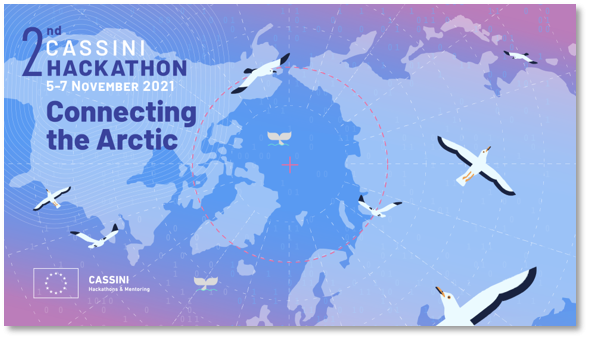
The Arctic is a fascinating and complex geographical, meteorological and biological ecosystem whose impact is significant and far-reaching. From its highly transited shipping routes that connect the Atlantic and Pacific oceans to its role in regulating global temperatures, the Arctic is responsible for much of the way we live.
The second CASSINI Hackathon took place on 5-7 November 2021 with a focus on this extraordinary region. The challenge was to develop ideas that help maintaining safe passage at sea, assist life on land, and safeguard its native wildlife. Hundreds of participants came together over a weekend to protect, support and strengthen the Arctic using European space data, signals, and technologies.
The CASSINI Hackathons and Mentoring, initiated by the European Commission via its space programme, is a series of six hackathons that tackle global challenges using European space technologies. Now approaching its third edition, these hackathons provide access to pre-processed Copernicus data, on-demand training, and other valuable tools to help participants take on one of three challenges within the theme of each edition. The best ideas are awarded at both local and EU levels, and the overall winners gain entry into a six-month mentoring programme that includes 100 hours of customised expert mentoring.
The 2nd CASSINI Hackathon took place in 10 European countries simultaneously with a shared goal: to solve the challenges faced in the Arctic region. Participating teams faced three different challenges and were tasked to address one or more of them:
- Safe passage at sea
- Life on land
- Caring for our wildlife
At the end of the hackathon weekend, more than 70 projects were submitted by close to 300 innovators. The most popular challenge participants chose to address was life on land. Teams were asked to develop ideas or design products, devices, or services that improve our understanding of the effects of climate change in the Northern regions or mitigate the impact of these changes. Many other projects focused on developing services that ensure seafaring vessels have safe passage at sea and developed ideas to better understand and protect the wildlife.
The top teams from each location were selected by the local jury members to move forward to the Demo Day & Awards Ceremony on 10 November. Read more about the local winners’ projects on the CASSINI Hackathon portfolio page.
During the Demo Day & Awards Ceremony, each of the 10 local winners had the opportunity to present their ideas in a 2-minute pitch to the expert jury. Following the live pitches, jury members interviewed each team before moving to their evaluations. It was clear that each team had worked hard on their pitches and presentations, making the decision very tough! Meet the three winning teams:
1st Place: Arctic Soil Erosion from the CASSINI Hackathon Iceland
Arctic Soil Erosion uses satellite imagery to create a searchable map that identifies locations with a high risk of erosion.
2nd Place: PolarBearings from the CASSINI Hackathon Germany
PolarBearings is an AI-based polar navigation platform that provides optimal routing for terrestrial vehicles in the Arctic.
3rd Place: IceBlink from the CASSINI Hackathon France.
IceBlink provides navigation support including ice detection for vessels in the polar seas using remote sensing.
Each of the three winning teams won 100 hours of expert mentoring to support them with the development of their ideas. We are looking forward to seeing these teams transform their ideas into products and services throughout the mentoring programme and beyond!
If you are interested in becoming part of this exciting European initiative to promote EU Space technology and its many applications, find out more information: hackathons.cassini.eu
Challenges of “Connecting the Arctic” Hackathon:
1. Safe passage at sea: design products, devices or services that enable container ships, cruise liners and fishing trawlers to navigate safely across our Nordic Seas. If you choose this challenge, you’ll be encouraged to dive into the areas of navigation route optimisation, extreme weather and sea ice warnings, the development and connectivity of future shipping lanes, and environmental disaster and emergency management.
2. Life on land: design products, devices or services that enable human societies, plants and wildlife to better adapt to the Arctic climate. If you choose this challenge, you’ll be encouraged to explore topics such as environmental monitoring and climate change mitigation, renewable energy advancements, environmental protection, and the improved connectivity for research stations in remote areas.
3. Caring for our wildlife: design products, devices or services that can help protect biodiversity and the natural habitat of wildlife in the Arctic. If you choose this challenge, you’ll be encouraged to focus on protecting marine biodiversity, understanding and forecasting mitigation routes, understanding and mitigating the effects of exploration and development on wildlife, and the impact of climate change on natural habitats.
Details
- Publication date
- 31 January 2022
